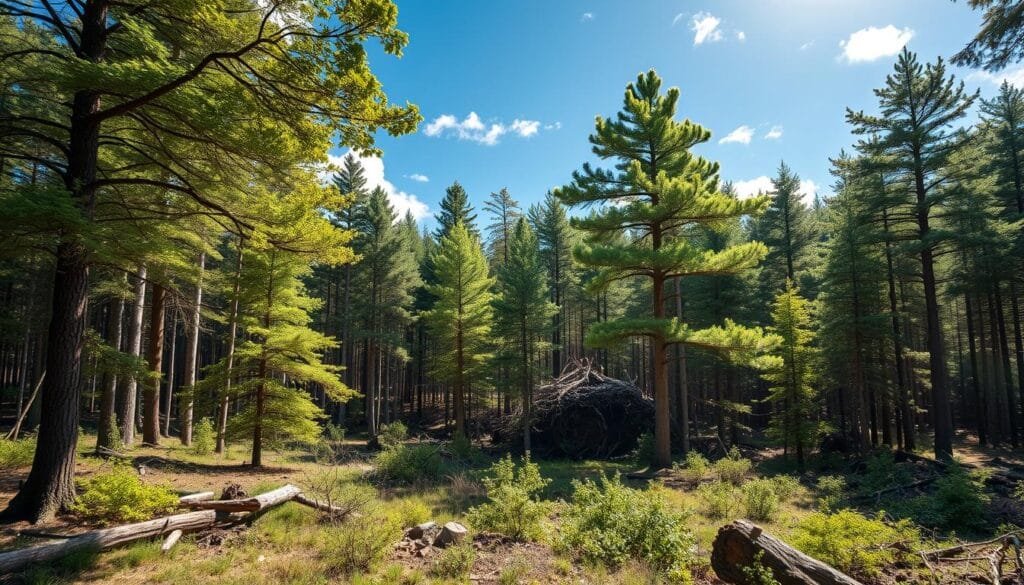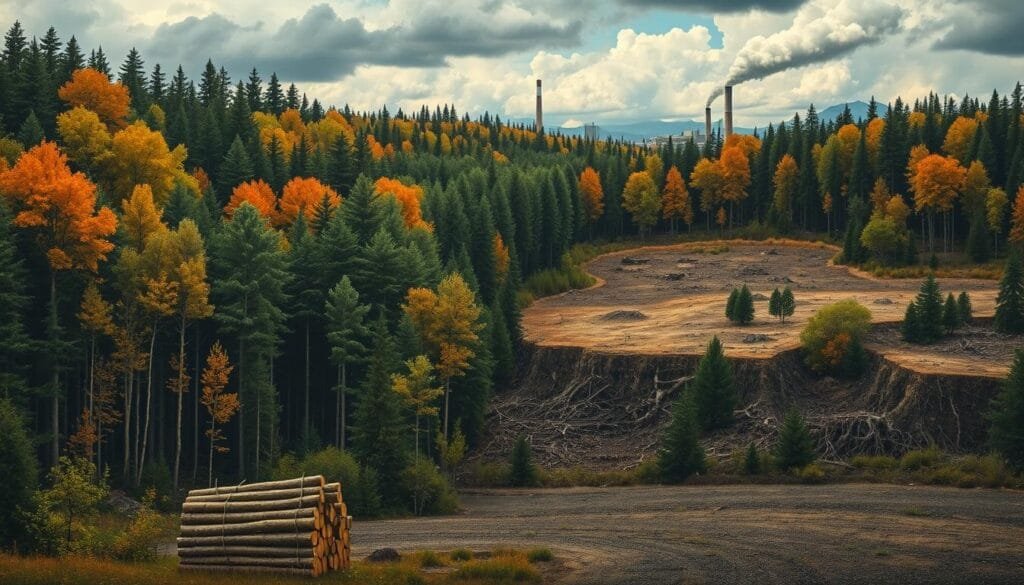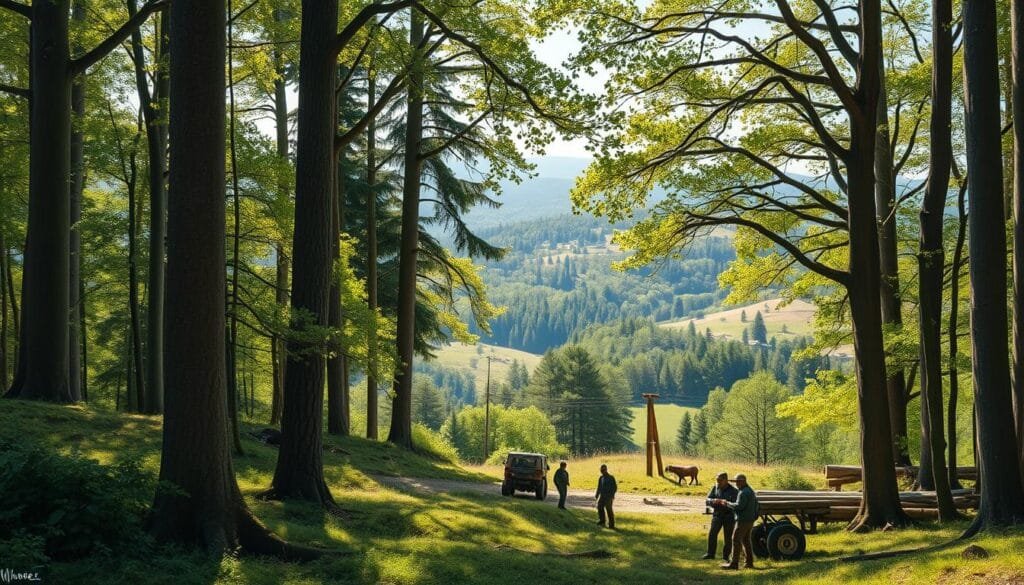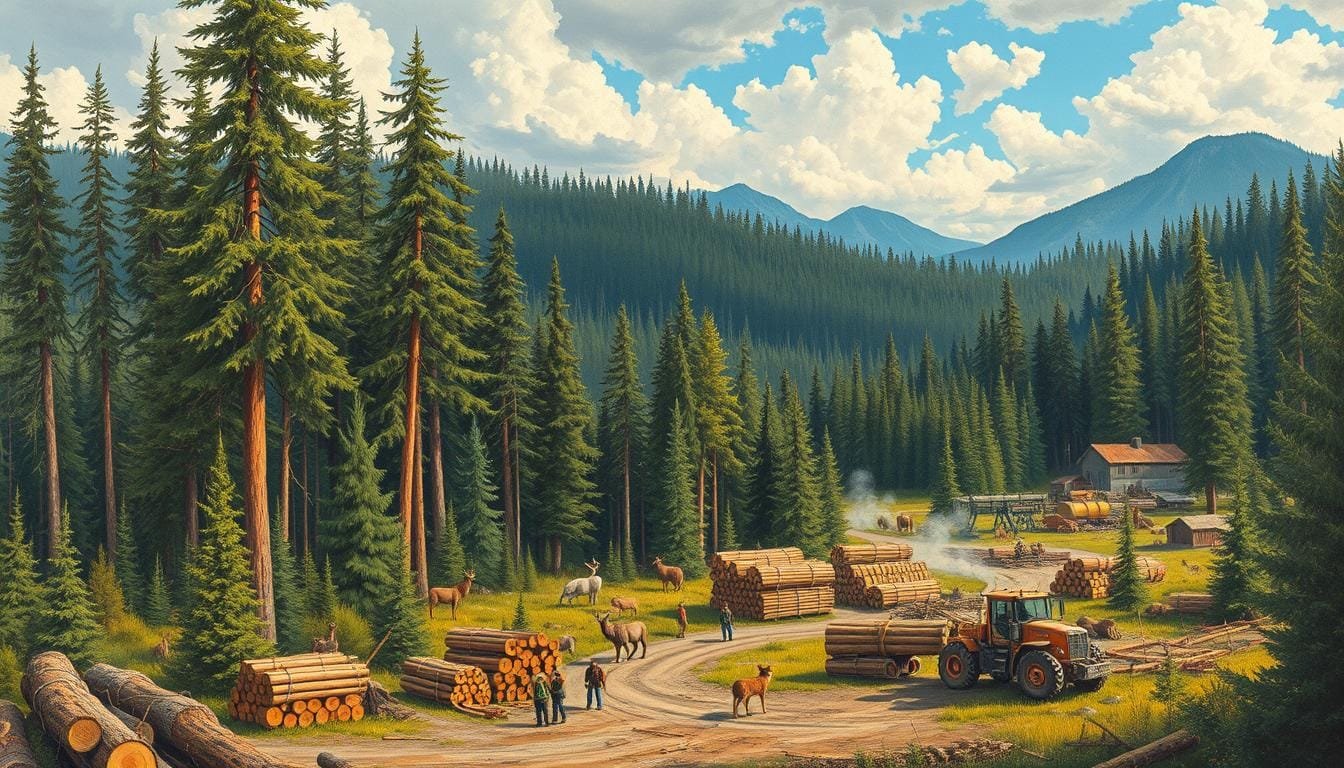Timber resources play a huge part in the timber economy and, broadly speaking, the world’s economy too. We look at the big picture and details, from how timber supports local economies to its role in making furniture. This highlights timber not just as a tool but as an art and a force for environmental conservation.
More than a mere product, timber affects the lives of over 1.5 billion people, or 20% of people worldwide. It plays a key role in many areas of life.
Key Takeaways
- Timber is crucial for the global economy, especially in building, making things, and creating furniture.
- Using timber as a renewable resource helps the environment and promotes sustainable work methods.
- Areas focused on forestry see more jobs and income thanks to timber resources.
- It’s important to manage timber resources well to keep local economies strong and the environment healthy.
- Many people depend on forests, showing how important it is to take care of them.
- The variety of timber, from bamboo to oak, presents many uses and values. Each type offers different benefits and chances for sustainability.
Introduction to Timber in the Global Economy
The timber industry plays a huge role in the world’s economy, thanks to diverse forests around the globe. These forests are not just trees. They are economic powerhouses the global population depends on.
In the U.S., forests and woodlands cover 823 million acres. This large area supports a thriving timber market. Each year, the forest industry adds more than $200 billion to the U.S. economy. It also provides jobs for about 955,400 people as of 2018.
An interesting fact is that 46% of U.S. timberland, or 209 million acres, is in the South. This shows the region’s economic strength and the wide variety of forests it holds.
Ownership of timberland in the U.S. includes 37.6 million acres held by foreign entities, making up 2.9% of such land in 2020. Even more interesting, 46% of this foreign-held land is forest. That’s around 17.8 million acres groomed for timber, a key part of the global timber trade.
Forests are the world’s largest land carbon sinks, capturing 90% of the carbon stored on land. They reduce the U.S. fossil fuel impact by 15%. Every 100 trees remove 53 tons of CO2 from the atmosphere yearly. Private forests work even harder, sequestering 20 times more carbon than national forests.
| Region | Timberland (million acres) | Annual Carbon Sequestration (tons) |
|---|---|---|
| South | 209 | 11097 |
| Northwest | 94 | 4982 |
| Midwest | 61 | 3233 |
| Appalachia | 50 | 2650 |
| Northeast | 41 | 2173 |
This study shows how critical forests are economically and for the environment. They are a key to balancing economic needs with ecological health.
What is the economic importance of timber
Timber is a key natural resource for the world’s economy. It impacts many areas from building homes to trading globally. Its use and management support local economies. They also show the value of using resources wisely.
The Role of Timber in Construction and Manufacturing
Timber is widely used in construction to build houses and big commercial spaces. It is used for beams, studs, and joists, showing its value in building. Timber is also crucial in making paper products and other materials.
Its ability to replace materials like steel shows how versatile timber is. This makes it vital in many production fields.
Timber’s Contribution to Employment and Rural Development
The timber industry creates many jobs around the world. It is especially important for rural areas. The industry supports local growth through jobs in cutting, processing, and selling timber.
Using sustainable methods helps keep the environment healthy. It also provides stable jobs, supporting rural communities and economic growth.
Export Revenues from Timber: A Global Perspective
Timber exports are crucial for countries with lots of forests. They bring in significant income. This trade benefits both local and global markets, making timber key in international trade.
Forestry income is vital for a country’s economy. It shows how important timber trade is worldwide. The connections between production, jobs, and exports show timber’s role in economic health and nature’s balance. Managing timber well is essential.
The Sustainable Management of Timber Resources
Sustainable forestry ensures we have timber forever. It keeps forests healthy and protects biodiversity. By managing forests well, we get timber and help nature and people too.
In New South Wales (NSW), Australia, we use only 2.5% of land for forestry. This shows we care about the environment. Notably, 7% of forests go to timber. Meanwhile, 30% is for parks and conservation, showing we value biodiversity.
Regional Forest Agreements are key. They balance economy and environment, helping us today and tomorrow.
The NSW Forestry Corporation manages over 2 million hectares. They focus on practices that keep forests and biodiversity thriving. They follow the Forest Practices Code, setting high standards for cutting trees to protect ecosystems.

Integrated forest operations approvals (IFOAs) put over 2000 rules on forestry. These rules aim at better regulation and forest health. They limit environmental harm, ensuring we always have timber.
Sustainable forestry fights global issues like climate change and soil erosion. Forests absorb carbon, and with good management, we enhance this. This keeps our planet healthier.
This forestry is good for the economy too. It creates jobs, boosts local economies, and supports regional growth. The NSW Forest Agreements bring long-term certainty to the industry, helping conservation and communities.
Sustainable forestry is crucial for timber, forests, and biodiversity. These methods make sure forests keep benefiting everyone. Our economy and wellbeing also grow thanks to forests.
Here’s proof sustainable forestry works in New South Wales:
| Aspect | Detail |
|---|---|
| Land Use for Forestry | 2.5% of NSW land mass |
| Timber Production Areas | 7% of forests designated |
| Conservation and National Parks | 30% reserved as protected areas |
In closing, with proper plans and dedication, sustainable timber management is vital. It ensures our forests thrive and secures a bright future for all.
Challenges Facing the Timber Industry
The timber industry is vital to our economy but faces serious challenges. These include pest infestations and climate change effects. Both of these threats can cause big economic problems.
Pest Infestations and Their Economic Impact
One of the biggest threats to timber is pest infestations. Pests like the mountain pine beetle damage forests in North America. They harm the trees and can lead to lots of forest being lost. This loss damages the environment and hits industries hard financially. Fighting these pests takes a lot of money, making it a big problem for the forest industry.
Deforestation and Its Economic Consequences
Deforestation, or clear-cutting, is another major issue. It destroys forest ecosystems and hurts biodiversity. It also affects indigenous populations who depend on forests. Plus, it leaves areas more open to natural disasters like landslides. This makes it tougher for local and global markets. That’s why sustainable timber practices are so important.
The Threat of Climate Change to Timber Resources
Climate change is causing big problems for timber. It leads to more forest fires, which are getting worse. These fires don’t just destroy timber. They also make it harder for forests to grow back. We need good plans to deal with these issues to keep the timber industry going.

Case Study: The United Kingdom’s Timber Trade
The UK timber industry stands out for its strong focus on sustainability. It aims to boost domestic timber production while caring for the environment. This is achieved through strict certifications and new forestry practices that benefit both the economy and nature.
The United Kingdom, though modest in forest resources, plays a pivotal role in shifting towards sustainability. It leads in using responsible forest management. This is supported by strong certification systems like the Forest Stewardship Council (FSC) and the Programme for the Endorsement of Forest Certification (PEFC). These programs make sure wood products come from well-managed forests.

The UK timber industry focuses on more than just following laws. It integrates sustainability deeply into its business practices. The goal is to move all its timber trade to sustainable and legal sources. This aim supports the global objectives of groups like the World Wildlife Fund (WWF).
Here are key points about the UK’s sustainable timber efforts:
| Focus Area | Statistic | Impact |
|---|---|---|
| WWF’s Zero Deforestation Goal | 2020 Target | Promotes biodiversity and reduces carbon footprint |
| Forestry Certifications | FSC and PEFC Compliance | Ensures product traceability and sustainable practises |
| Economic Value | $17.6 trillion in forest ecosystem services | Supports millions globally, stabilizes economies |
| Sustainable Practices | Regenerative Forestry | Prioritizes long-term ecological health |
The UK timber industry shows a strong balance between keeping the economy strong and protecting nature. By managing forests well, the UK not only boosts its timber output. It also plays a big part in global efforts to be more sustainable, setting an example for other countries to follow.
Benefits of Sustainable Timber Markets
The search for sustainable timber markets is key to balancing needs with care for our environment and society. By choosing sustainable sources, industries help protect our ecosystems. This also ensures forests grow back in a sustainable way. These actions are crucial for our economy and for keeping political stability.
Environmental Benefits and Economic Growth
Sustainable timber markets are vital for helping over 1.5 billion people around the world escape poverty. They provide important services that add up to about US$17.6 trillion globally. These methods also fight climate change and protect different species, ensuring forests thrive. This is essential for the health of our planet, aiding communities, and economic growth worldwide.
Securing Long-term Supply for the Timber Industry
For the timber industry, having a reliable supply chain is important for sustainability. Over 16% of global trade comes from timber and paper products. Adhering to certified sustainable practices ensures that timber is available for future use. This supports economic stability and job creation. Using local sources also reduces carbon emissions and boosts the local economy.
Corporate Social Responsibility and Brand Image
Investing in sustainable timber meets corporate social responsibility and boosts a company’s image. Businesses known for their sustainability efforts often gain trust from consumers and investors. This trust can lead to better financial results and make a company stand out. Including employees in these green efforts also helps create a positive work culture, leading to success.
| Statistical Metric | Value | Impact/Relevance |
|---|---|---|
| Global value of ecosystem services from forests | US$17.6 trillion | Highlights the massive economic value forests contribute globally through ecosystem services beyond timber. |
| Percent of global trade tied to timber and paper | 16% | Stresses the significant part timber plays in global commerce, underscoring the need for sustainable management. |
| Jobs created per million dollars in timber sales | Approx. 35 (12.3 direct, 15.5 indirect, 7.3 induced) | Shows the considerable employment potential of sustainable timber markets, beneficial for economic growth. |
As we work on better methods for sustainable timber, its vast benefits become more evident. It leads to economic stability, environmental health, and social wellbeing. Sustainable timber is crucial for the welfare of future generations.
The Future of Timber: Trends and Predictions
The future’s demand for timber shapes the market, with global timber demand playing a big role. We’re seeing a shift towards sustainable forestry trends. Let’s explore what drives these changes and possible future scenarios.
Prices and production in the timber industry have been up and down. For example, Eastern SPF lumber prices dropped sharply in early 2024. This shows the impact of broader economic challenges on the industry’s sustainability and profits.
| Statistic | Details |
|---|---|
| Total 2023 hardwood production in the Northeast | Lowest in several years |
| 2024 Winter Harvest Season Duration | Reduced to half compared to typical ~3-month period |
| Demand for Industrial Grade Hardwood Lumber | Remains strong, indicating positive outlook |
There’s a bright side too. The need for industrial hardwood lumber remains high. This is good news for businesses focusing on products like crane mats and pallets.
Green building practices are becoming more widespread. The market for nonresidential green buildings jumped to $80 billion in 2020. It’s expected to reach $103 billion by 2023. This rise reflects the growing demand for sustainable options.
Mass timber projects in the U.S. are also gaining ground. By December 2020, there were over 1,060 such projects. They are likely to keep growing, powered by new construction methods. These innovations can speed up building times and reduce costs significantly.
Looking ahead, we see various factors shaping the timber market. Policy changes, economic incentives, and climate issues will play a role. The demand for timber is expected to grow, especially with more roundwood production by 2050. This underscores the need for sustainable forestry.
In closing, innovation, sustainability, and flexibility are key for the timber industry’s future. Stakeholders must understand these trends to seize new opportunities and overcome challenges.
Conclusion
We’ve looked at how important timber is for the economy, jobs, and rural areas. This journey showed us timber’s key role in different sectors, especially building and making things. Despite using wood faster than forests can grow, especially in the Asia-Pacific area in the last 15 years, we see the urgent need for sustainable forestry.
As economies and environments change, sustainable methods become crucial. This is due to environmental worries, policy talks, better management, and tech progress in managing forests and plantations. In the Asia-Pacific, private companies are helping make plantations more sustainable. Also, cities growing and new tech have changed how we value forests, focusing on smaller, quicker-growing trees.
Looking ahead, economic growth, more cities, and care for the environment will bring new tech changes in managing forests and processing wood. How well we do in sustainable forestry will shape the future of timber in both local and worldwide economies. Programs like the Augusta Heritage Center’s educational efforts and the Appalachian String Band Music Festival highlight the value of our natural resources. In the West Virginia Hardwood Alliance Zone, almost 400 companies show that it’s possible to balance economic health and sustainability, promising a bright future for both the timber industry and our planet.
FAQ
What is the role of timber in the global economy?
Timber is very important in the world’s economy. It is key for industries like building, making paper, and creating furniture. It is something that grows back, giving jobs and money to areas where lots of trees are. By managing it well, we help the environment and keep forests and their living creatures healthy.
How does timber contribute to employment and rural development?
Managing timber creates lots of jobs all over the world. It helps not just country areas with logging work, but also big city jobs. Think about building houses or making furniture. Having these jobs is vital for keeping local places strong and giving more job chances in the woods business.
In what ways does exporting timber affect local economies?
When we send timber to other countries, it really helps local pockets. It’s a big deal for communities that need the forest to live. This trade shows how important wood is everywhere. And, selling timber abroad makes life better for people working with trees at home.
What is sustainable forestry and why is it important?
Sustainable forestry means taking care of forests so they stay healthy and full of life. We make sure trees can keep growing back. Doing it this way keeps the forest and animals safe. It stops trees from disappearing and makes sure people later can have trees too.
What economic impacts arise from pest infestations in forests?
Bugs like the mountain pine beetle can really hurt a lot of trees. When trees get sick, we lose them and people’s jobs can be at risk. Places that depend on trees can lose money and many might find it hard to earn a living from the forest.
How does deforestation affect forest ecosystems and economies?
Cutting down too many trees at once is bad for forest life. It leads to less ground being held down and fewer animals living there. People who live close and use the forest get hit hard. This messes up jobs and the health of the area’s economy too.
How does climate change threaten timber resources?
Climate change makes forest fires more common and messes with the weather trees need to grow. It can really harm how much wood we have and how we look after forests. Big heat, less rain, and storms hurt their health and the jobs that depend on them.
How is the United Kingdom addressing sustainable timber management?
The UK is really focusing on using forests in a way that keeps them for future use. They support efforts like the Forest Priority so businesses get wood from good sources. This matches global aims to stop forests from going away, like the WWF wants.
What are the benefits of sustainable timber markets?
Having a market for eco-friendly wood helps keep forest jobs and helps nature too. It’s good for trapping carbon, managing water, and keeping the ground in place. This approach helps reduce poverty, keep peace, and grow wealth by balancing nature and needs.
Why is supply chain integrity crucial for sustainable timber markets?
Keeping the wood collection honest makes sure we use trees wisely. We need to make sure trees grow faster than we cut them down. It’s about making a profit without hurting the forest. We also protect both well-known and rare trees, keeping the woods healthy all around.
How can sustainable sourcing of timber benefit corporations?
Using sustainable wood can save money, make rules easier, and help with getting funds. It makes the brand look good, keeps employees happy, and might make more money. This good action raises a company’s reputation and wins over customers.
What trends are shaping the future of the timber trade?
Trends show that taking care of forests wisely is critical for timber’s future. Without it, the timber business could falter. Going green can reduce climate issues and ensure we have enough wood. This is key for world trade and many companies’ success.
